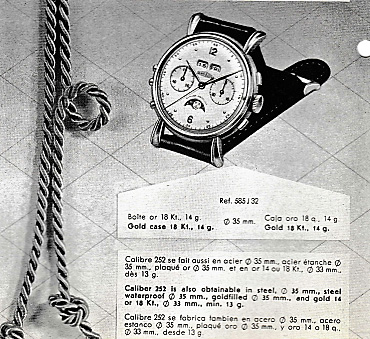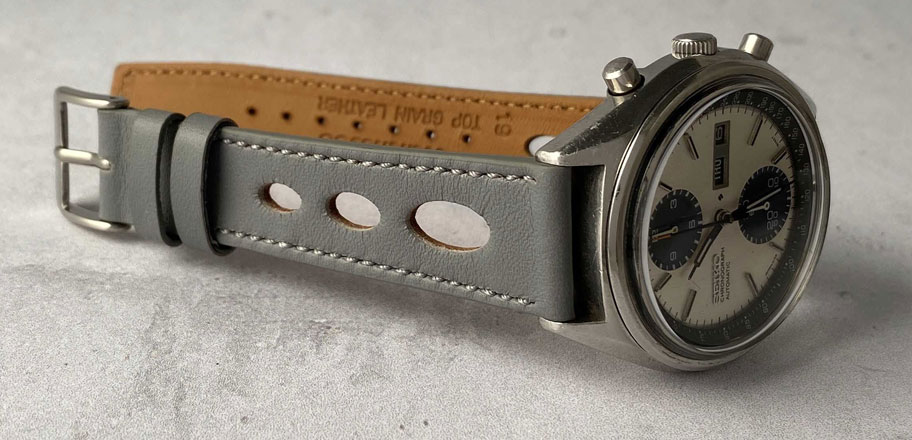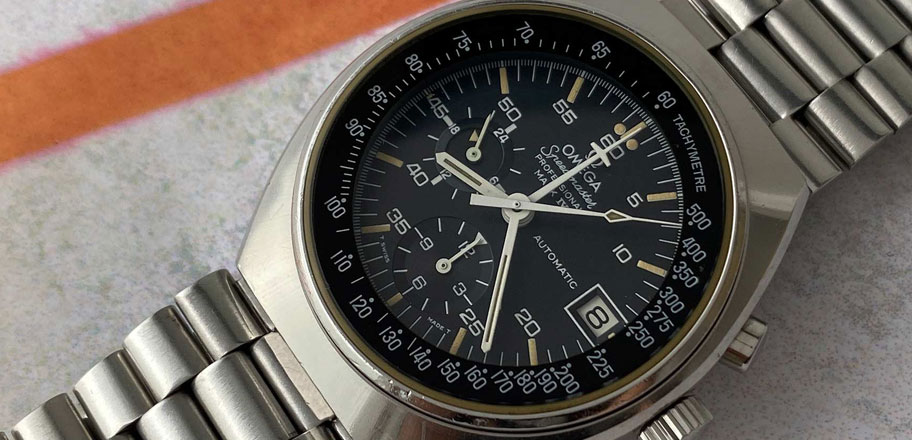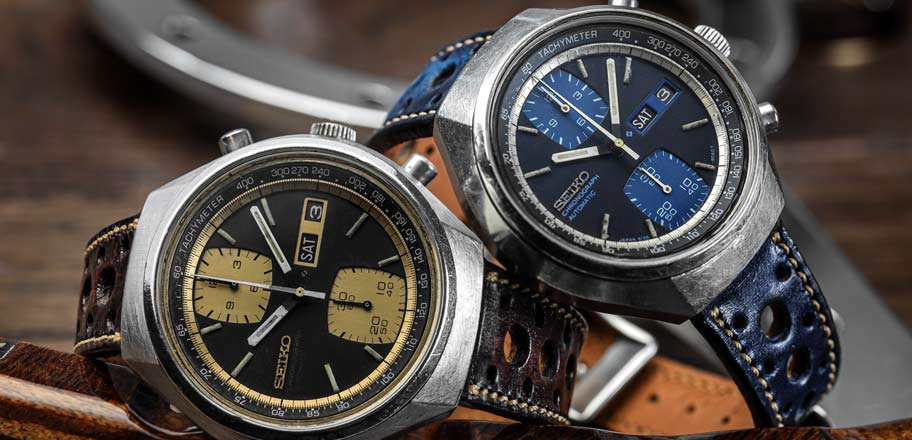Angelus Chronodato: a “cult” watch among vintage fans (Part 1/2)

In-house versus third-party mechanical watch movements (Part 2/2)
29 November 2018
Angelus Chronodato: a “cult” watch among vintage fans (Part 2/2)
24 December 2018“In Watches83 we are in luck, the reason, this impressive article about the legendary Angelus Chronodato that our friend Miquel Angel Cladera has given us. Sometimes, a research exercise on a piece so little historiated reaches this exalted level. Naturally, the unfortunate thing is that the author pretends to take over the knowledge, just the opposite of what Miquel has done, thanks for sharing your brilliant work with all the readers of our Blog, which, as in previous articles, we have divided this post in two parts, this being the first one. Touch to read and enjoy”
WRITTEN BY
MIQUEL ANGEL CLADERA
I still remember with enthusiasm when, and for quite some time now, I had the Angelus Chronodato in my hands. The watch was in very bad condition, but still it gave me something different, something special. Over the years and some delicate mechanical repair I have learned to appreciate it as it deserves, because this watch deserves a prominent place in the world of vintage watchmaking. Thanks to Sigfrid and Sílvia from Watches83, I am now going to try to articulate the history of this object of desire that today constitutes the Angelus Chronodato among collectors and lovers of vintage watches. It is a great luck to have in our country a portal like watches83.com where the professionalism and good work of its managers are equated with their passion and affection for vintage watches. Something really important, when you’re used to dealing with people who do not see beyond the object of your business, vintage watches. From here I wish you good luck in this project (watches83.com) that little by little is firmly established and broadly disseminated to your blog (watches83.com/blog) that will serve the fans of learning medium and why not, to try to contribute some of our little knowledge in the wonderful world of vintage watches..
ANGELUS CHRONODATO
A few years ago, looking for information on the network about vintage watches, I accidentally stumbled upon a photograph, namely:
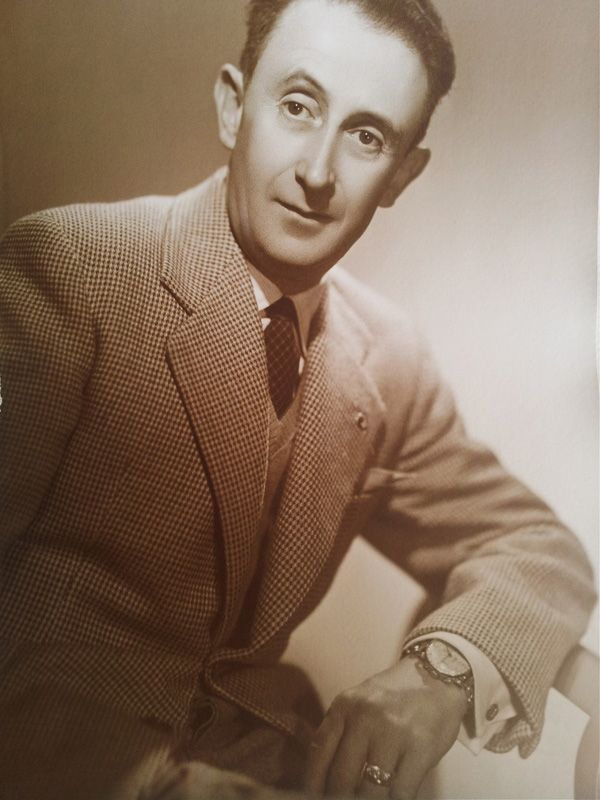
Apparently this photograph (found on the Madrid Trail) was taken at the beginning of the 1940s. At first glance it does not represent much, it is a portrait of an anonymous character; a young man dressed in fashion that the passing of time has already erased from his memory. But if we situate ourselves in context and pay close attention, we can deduce or rather speculate several things. Year 1943: Europe was at war and lived a delicate and tragic situation; the lack of basic resources, food and insecurity makes this anonymous person a privileged person (not everyone could make a portrait posing with gallantry, showing their success, dressing in fashion and wearing their jewels deliberately) An industrial of success? A wealthy bourgeois for his flourishing trade? If we zoom in on his left arm, we see that, indeed, an Angelus Chronodato looks!
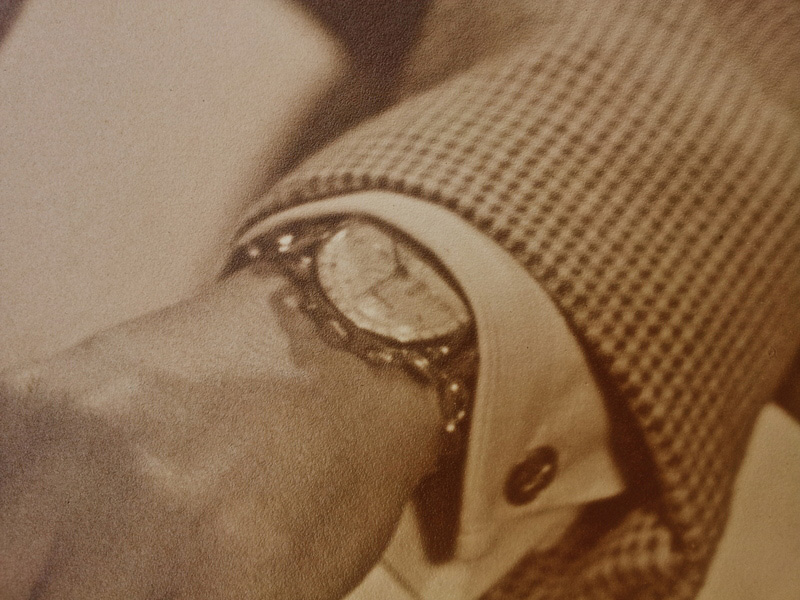
As far as I know, this is the only non-publicity photograph of a character, wearing a Chronodato. Returning to the historical context and based on the empirical test of the languages that can be found on the date disc of the Chronodato (Portuguese, Spanish, French, English and German) It is possible that this character lived or had his business installed in some country Far from the vicissitudes of war, taking advantage of the war, their economies flourished, either by exporting their raw materials or by manufacturing them, as were the main importers of this magnificent watch (Germany, Switzerland, Brazil, Argentina, USA, France) but to that we will return later. Specifying a little more, what can we extract from all these “speculations”? We can conclude that the Angelus Chronodato, was in its time a fashion watch, successful and had the honor, within the history of watchmaking to be the first chronograph manufacture with the complication of triple calendar manufactured in series.
The Stolz Frères manufactory
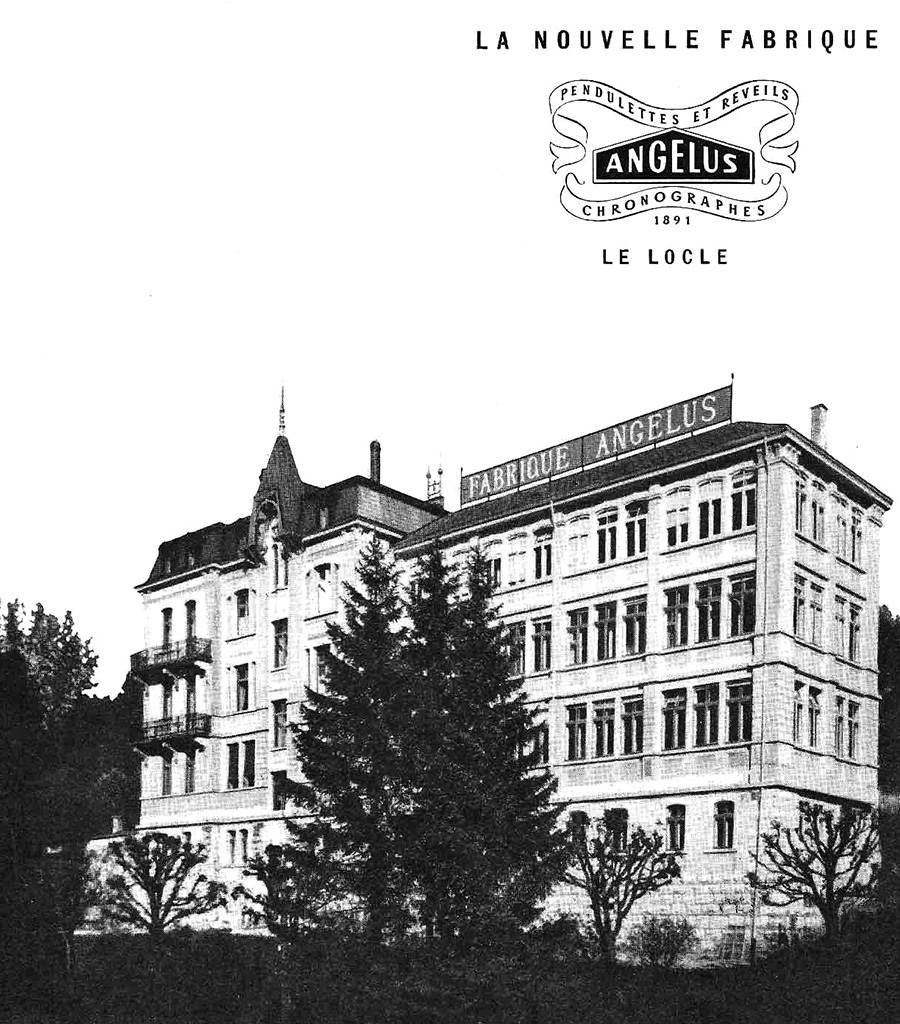
I am not going to extend too much in the history of the “Maison Stolz Frères” who may want to consult some links with more information at the end of the article, but if I am going to point out its most relevant aspects (1)
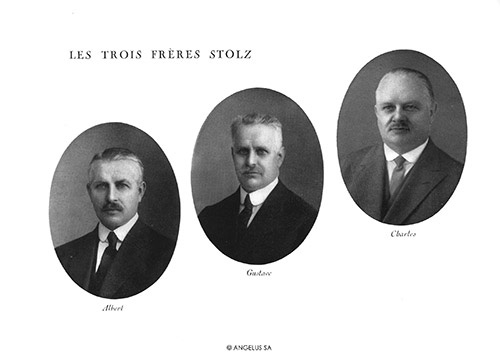
(1) On the website of the current Angelus, we find this information related to its history, although it is true, little documented, which seems unusual to me
La Maison Stolz Frères was founded by the Stolz brothers in 1891 in the town of Le-Locle, one of the three nerve centers of Swiss and global watchmaking at the time. Its principles were modest, almost handmade, working in small workshops and making their watches with Ebauches (2), but soon the relative success (thanks to the specialization of creating pocket watches with complications and chronographs, which were exported to countries like Italy, Germany or Russia, make them move to their own headquarters and begin to manufacture their own calibers and their own brand “Angelus” in 1904. During the next decade, specialize in creating manufactures of pocket and table watches with great complications, as the repetition of minutes, chronographs with lunar phases.
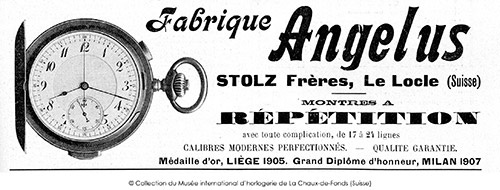
This is one of the first known advertisements of the Maison Stolz Frères
And it is during this golden decade that the Maison begins to win gold medals with its creations in several exhibitions, such as in Liège, in addition to international recognition. The arrival of World War I, makes the activity of the company slow down. However, they create a minute repeater watch for the blind (some of them offered free of charge to famous soldiers who suffered the loss of their vision in the great war, an occasion that even Marshal Joffré thanks in a public letter of recognition and gratitude (3 )).
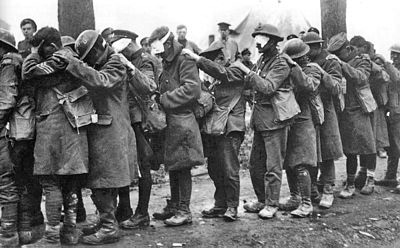
(2) They worked in small workshops and in rooms, in an artisanal way, assembling the movements and pieces commissioned to third parties (ebauches)
(3) One of the most common injuries in the great war was the blindness caused by chlorine gas. I could not find the letter from Marshal Joffré
http://www.wikiwand.com/es/Gas_venenoso_en_la_Primera_Guerra_Mundial
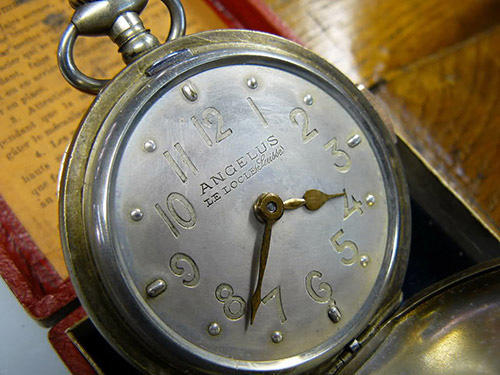
In the first years after the war, the already established use of the radio, as luminesceste material, condemns to the second plane the repetition watches, which was one of the star products of Angelus. This setback causes the company to put more emphasis on the manufacture of travel and table watches, with complications of alarm, chronograph and with a hand wind load of 8 days duration (4).
From here I will focus more on the appearance of the wrist chronographs of the Maison, which really are the germ of the watch that occupies us in this article.
The chronographs of Angelus
(4) It was one of the most difficult periods of the Maison, to avoid bankruptcy, but the putting into fashion of wrist chronographs initiated by Breitling and their firm commitment to them took them out of the deep financial crisis.
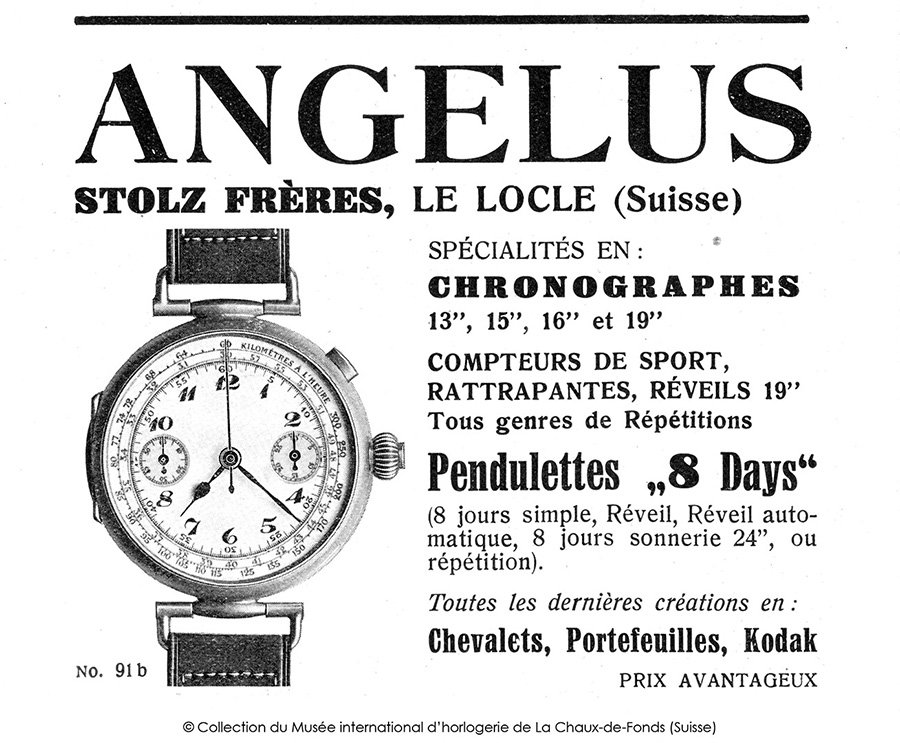
First advertising image of a known chronograph by Stolz Fréres
On the first Angelus chronographs there is really very little information or graphic document. They emerged in the decade between 1925 and 1935, were monopulsantes, with counters of 30 and 45 minutes. The gauges used in the 30m meters were Valjoux (5) ebouches and those of 45m manufacture. Here we have one of the first examples of manufacture, from the end of the 20s
(5) Ebauches SA subscribed a multitude of movements to most of the watchmaking houses of the time. The Stolz brothers firmly committed themselves to creating their own movements.
https://fr.wikipedia.org/wiki/%C3%89bauches_SA
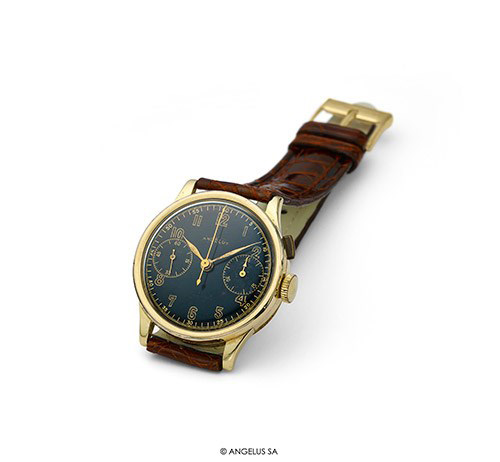
This monopulsador chrono used the first caliber chronograph manufacture, the SF15
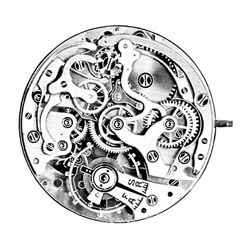
In 1933, Breitling brought out the first chrono with a double push button (6); Angelus is not going to lag behind and in 1935 finalizes the development of the caliber SF 210 used in versions of one and two buttons and brings to market its first chrono with two push buttons
(6) https://www.fratellowatches.com/vintage-breitling-the-expert-interviews/
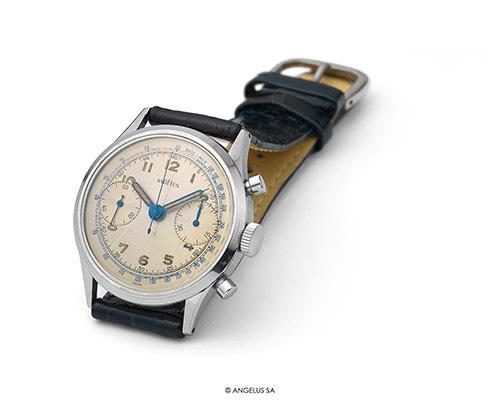
Or in its military version for its Hungarian forces (7)
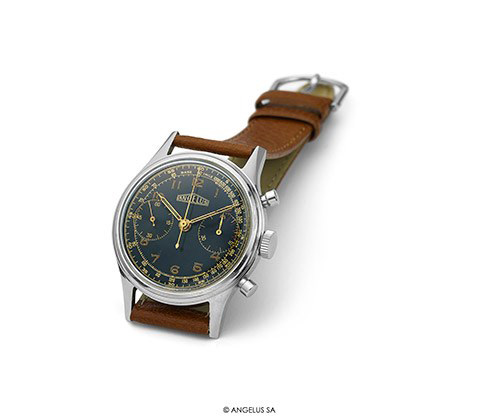
However, in some cases he continued to use Valjoux gauges in some of his first bi-pulsating chronos, like this one in the image of an old ad.
(7) This unique specimen is dated at the end of the 40s
https://www.fratellowatches.com/tbt-angelus-caliber-215-chronograph-l-e/
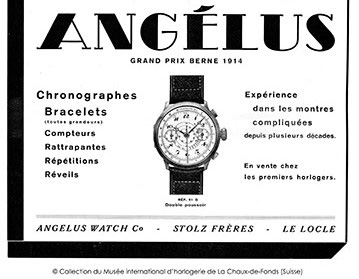
Here is an image of the caliber, which will be the basis of 215 and 217 (which uses the Chronodato)
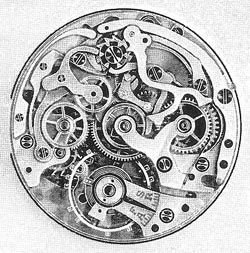
The success and reliability of its watches, makes the Maison Stolz Frères, relive another golden age and expansion. The entry in the register of the “Book of gold of watchmaking” participation with victory in chronometer contests of the observatory of Le- Locle and a great diversification and variety in the aesthetics of their chronoes, makes Angelus become a leading brand and in a reference the world of world watchmaking, This fame earns the esteem of the public, which translates into great sales successes and collaboration with different armies (Italian, Hungarian) Angelus’s relationship with Panerai is a reference in the history of “warlike” watchmaking (8)
(8) The first movement “adopted for the Italian navy was the SF 240
The truth about the PAM 203
https://www.panerai.com/es/es/aboutpanerai/history.html
In 1940, the well-known SF 215 caliber appears for two push-buttons and will become the spearhead of Angelus in the 1940s
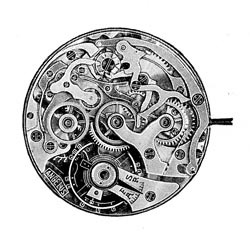
This caliber of 14 lines, manual charging and 40h of power reserve was used in a variety of watches, with different quadrants and various types of box. For example, this catalog from 1945 (9). This caliber was also used in the mythical Panerai “Mare Nostrum” of which very few units were made (10).
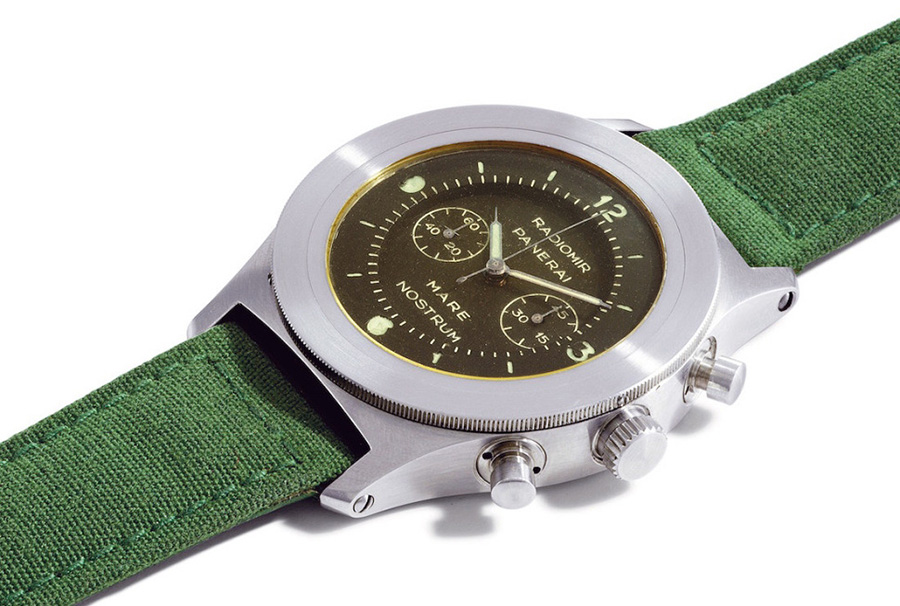
(9) This catalog is the only one that is kept complete on the Angelus brand and belonged to a sales representative in Mexico City. You can find images on different websites
http://www.invenitetfecit.com/
(10) https://perezcope.com/2016/06/16/the-mare-nostrum-prototype/
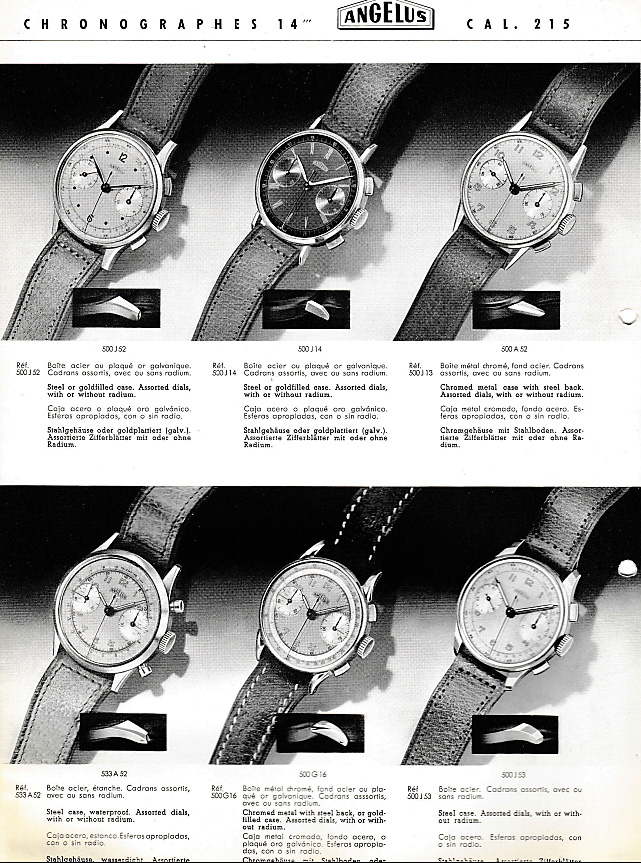
But it was not until 1942 when the Chronodato appeared, possibly in Angelus’s most famous chronograph.
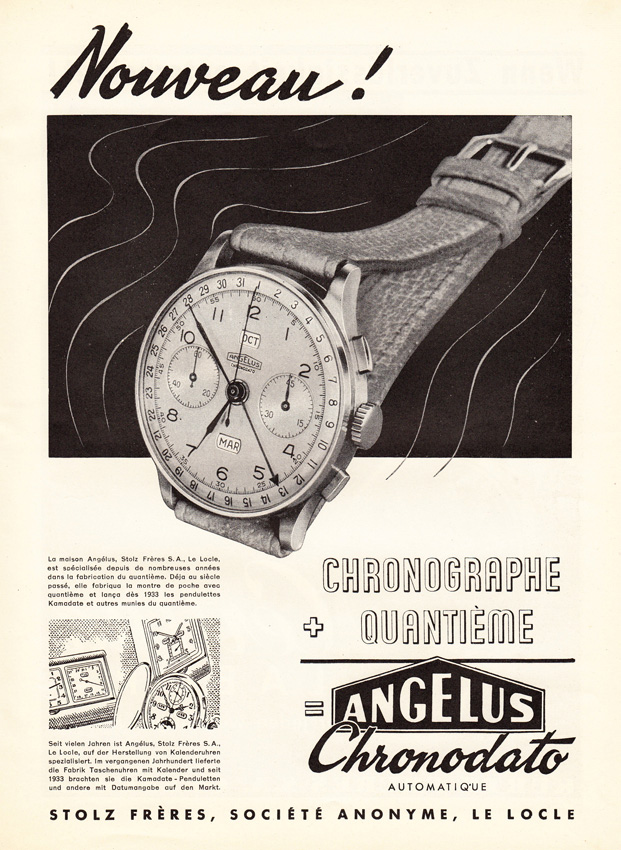
First advertising image of the known Angelus?
But what makes this watch so special, that in this last decade it has become an object of worship and an object of desire for many collectors? Lets go see it:
First, I would highlight that it is the first chronograph in the world to have a complete calendar and be manufactured in series. This is not a minor issue in the world of clockwork of “complications”. Never before any watchmaking house, had created this type of complication in the form of manufacturing and had launched it into the market. To give a few examples, of the most prestigious watchmaking houses, Patek Philippe (11) manufactured reference 1518 in 1941, which was a chrono with a perpetual calendar. This wonderful watch was built a few hundred units and its size was not manufactured, but it was a modification of an ebauche (valjoux 13Q)
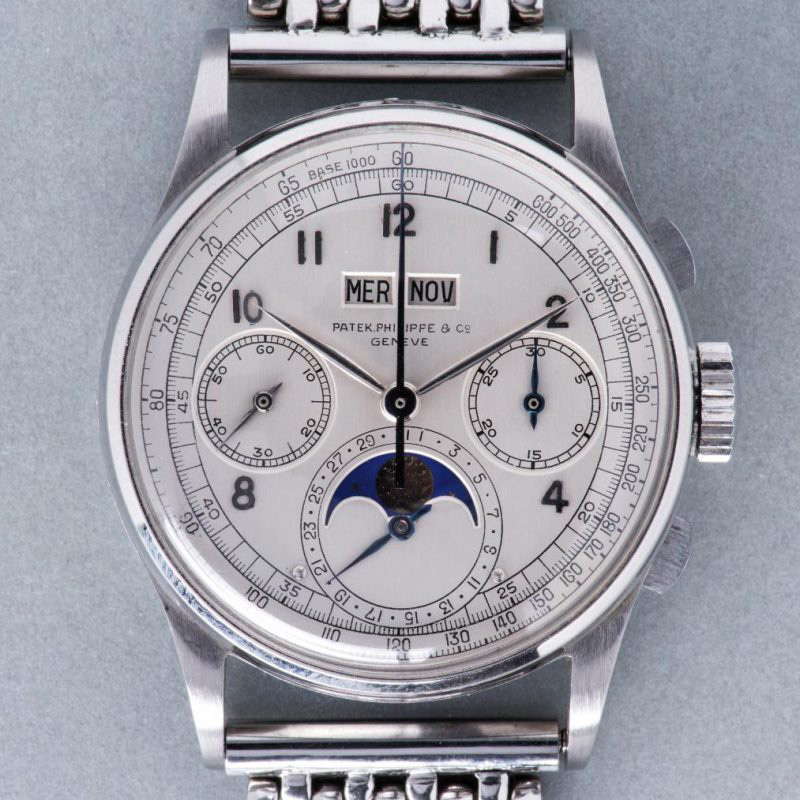
To cite another example, we find in the year 1942 another wonderful Horological example with this complication: the Audemars Piguet 13 VZAQ (12) that also nevertheless used another modification of the valjoux13 and still occurred in a shorter run than the PP.
(11) https://www.revolution.watch/the-story-of-the-patek-philippe-chronograph/
(12) https://deployant.com/the-curious-legacy-of-audemars-piguet-calendar-watches/
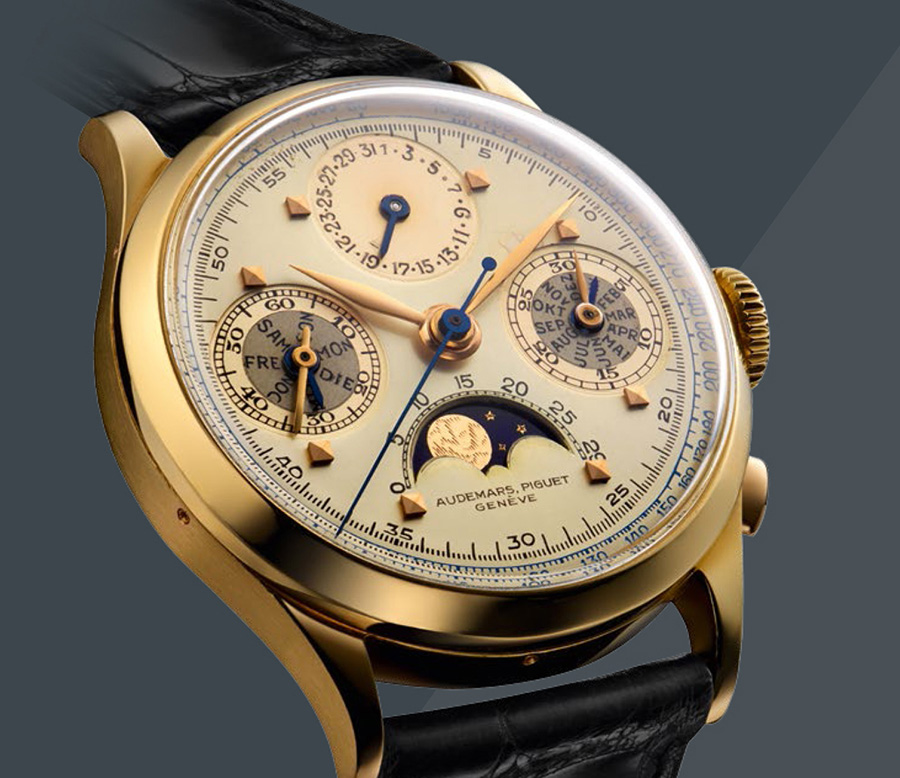
His most direct rival, Universal Geneve, created a series of chronographs with calendars (13), which however were not manufactures to use, but ebauches supplied by Martel (14), although on this subject, it would be advisable to investigate more thoroughly and accurately and This is not the right place now. Even so, I would like to mention Universal’s “Tri-compax” (1944) as one of the watches with the most media coverage, thanks to the fact that it was the watch worn by Harry Truman (15), president of the United States of America and witnessed mute of the Yalta agreements, during the last period of the Second World War. Angelus was not far behind and soon brought to market the Chronodatoluxe, already present in a catalog of 1945, but apparently released to the market a little later
(13) http://universalchrono.com/documentation
(14) https://www.relojes-especiales.com/foros/vintages/martel-universal-zenith-116139/post1414700/#post1414700
(15) https://www.hodinkee.com/articles/personal-timepieces-every-united-states-president-ever
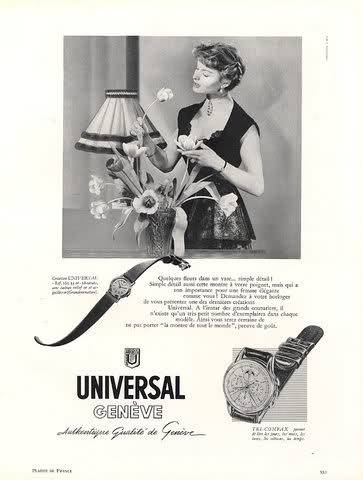
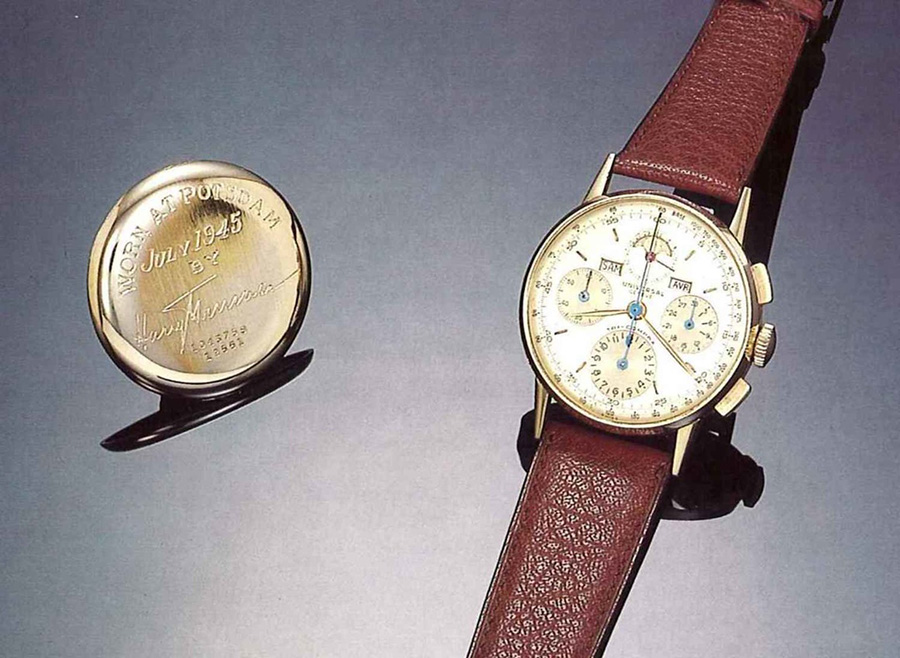
And here the no less interesting Chronodatoluxe (16)
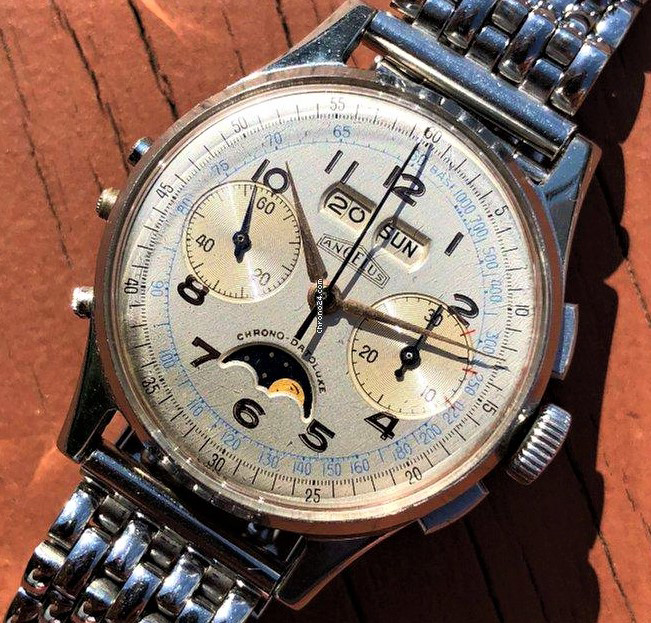
(16) https://www.fratellowatches.com/wp-content/uploads/2016/10/angelus-collectors-guide-2016.pdf where Mr. Christoph Öhm situates his appearance in 1948; late date in my opinion since it is announced as a next novelty in the catalog of 1945. Perhaps Mr. Christoph is based on the patent of the calendar disc dated 1947 that incorporates the family of chronograph calibres SF 250
